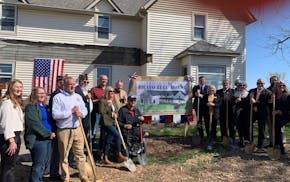The value of prairie grasses in Dakota County parks goes well beyond aesthetics.
If a recent vision of county government energy comes to pass, a field of grass could be a marketable crop, and maybe even the fuel that powers county vehicles or heats county buildings.
A 40-acre field of prairie grasses that could be used as biomass is just one idea in the energy plan recently approved by county commissioners. Others include a wind turbine on county property and energy-efficiency goals for county buildings.
The overall goal of the Dakota County Energy Framework is to reduce the county's greenhouse gas emissions, shift to renewable energy sources and knit sustainable practices into everyday local government activities.
The initial goal, which mirrors a plan crafted by the state, is to reduce the county's greenhouse gas emissions by 15 percent by 2015. If the ideas were enacted as outlined in the framework, it could also save the county $40,000 annually.
"We recognize the benefits of energy conservation," said Commissioner Tom Egan, noting the initial goals include plenty of "low-hanging fruit" and that more goals should be set in the future. "At that point, we can roll up our sleeves and get a lot more done."
27,210 tons of CO2
For starters, the county will work with its baseline inventory of greenhouse gases emitted in 2005 -- 27,210 metric tons of carbon dioxide.
According to Michelle Beeman, the county's director of environment and natural resources, that's equal to the amount produced by 8,000 cars annually. Or, put another way, equal to the amount of energy used by 2,000 homes each year.
Dakota County is the first in Minnesota to complete an inventory, set a target for reducing greenhouse gas emissions and outline a plan to meet the goal.
"The greenhouse gas inventory was a key piece of this because it's about how we're going to measure what we're doing," Beeman said.
It took staff from departments across the county about 18 months to analyze the energy use of just about everything the county did, from the effectiveness of insulation in county buildings to the electricity used by stoplights at intersections on county roads.
Then they trimmed a list of about 75 options to the eight strategies included in the report adopted this month.
In addition to the wind turbine and prairie grass biomass ideas, the county plans to further examine boosting employee recycling, increasing the efficiency of its vehicle fleet, promoting employee use of transit by subsidizing transit passes, using an "environmentally preferred" purchasing policy and making buildings more energy efficient.
The report also notes ways that the county could team up with cities, other agencies or residents to reduce greenhouse gas emissions. Encouraging transit use and recycling made that list, as did the idea of a "neighborhood energy sweep" in which teams would canvass neighborhoods and help residents improve the efficiency of their homes.
None of the ideas is set in stone, and many need further research and another round of approval from the county board before becoming a reality.
But just knowing that wind turbines and prairie grasses as biomass are being considered encourages Egan.
"What we're seeing here is there are new ideas percolating all the time that we didn't even know existed," he said. "That's what gives me tremendous optimism that we can really achieve something."
Katie Humphrey • 952-882-9056

Overdose deaths spike after incarceration, but Minnesota jails lack treatment

New sober house for veterans in southern Minnesota wants to treat the real issue: PTSD
Two North Loop condos combined into one 'dreamy' space listed for $649,900

